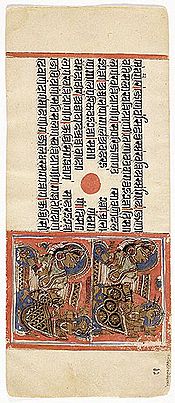- Niyamasara
-
Niyamasara is a 1st Century CE spiritual treatise by Kundakunda described by its commentators as the Bhagavat Shastra. It expounds the path of liberation.
Contents
Subject matter
Niyamasara deals with the three ethico-spiritual standpoints of understanding ultimate Reality –the Nishcaya naya, the Vyavahara naya and the Shuddha Naya.
Niyamasara effectively removes doubts related to Parayayarthika naya and Dravyarthika nayas and elaborates on Vyavahara caritra. He stresses that Vyavahara caritra is based on samyama (self-restraint) and hence rooted in appropriate psychic disposition. He places great stress on cleansing the soul of vibhavas, internal impurities,through self-discipline.
A unique feature of the Niyamasara is that Kundakunda characterises both Nichcaya caritra and Vyavahara caritra as tapa, or practice of austerity from their respective nayas. This characterization is based on psychological and pragmatic considerations and if put in practice properly it would lead to internal and external purity and annihilation of the four passions. Kundakunda concludes that Vyavahara caritra and Nishcaya caritra together constitute Samyak caritra. Another unique feature of this text is its description of parama samadhi, not found elsewhere in Jain literature.
Hindi Translation
Hindi translation of Niyamsaar
Gujarati Translation
Gujarati translation of Niyamsaar
Niyamasara Shastra
Pujya Gurudevshree Kanjiswami's Pravachan On Niyamasara Shastra
PDF
- Pravachan Ratnachintamani Part-1 In Gujarati
- Pravachan Ratnachintamani Part-2 In Gujarati
- Pravachan Ratnachintamani Part-3 In Gujarati
Audio
English Translation
NIYAMASARA: SALVATION THROUGH SELF-DISCIPLINE (Prakrit - English) Original Text in Prakrit By Acarya Kundakunda Translation and Introduction in English by J P Jain Sadhak, 2005 ISBN 8170272424
Śvetāmbara (Canonical Texts)
Angāgama Ācāranga sūtra • Sūtrakrtanga • Sthānānga • Samavāyānga • Vyākhyāprajñapti or Bhagavati sūtra • Jnātrdhārmakathāh • Upāsakadaśāh • Antakrddaaśāh • Anuttaraupapātikadaśāh • Praśnavyākaranani • Vipākaśruta • Drstivāda (Now Extinct)Upanga āgamas Aupapātika • Rājapraśnīya • Jīvājīvābhigama • Prajñāpana • Sūryaprajñapti • Jambūdvīpaprajñapti • Candraprajñapti • Nirayārvalī • Kalpāvatamsikāh • Puspikāh • Puspacūlikāh • VrasnidaśāhChedasūtra Ācāradaśāh • Brhatkalpa • Vyavahāra • Niśītha • Mahāniśītha • JītakalpaMūlasūtra Daśavaikālika • Uttarādhyayana • Āvaśyaka • PindaniryukytiPrakīrnaka sūtra Catuhśarana • Āturapratyākhyanā • Bhaktaparijñā • Samstāraka • Tandulavaicarika • Candravedhyāka • Devendrastava • Ganividyā • Mahāpratyākhyanā • VīrastavaCūlikasūtra Nandī-sūtra • Anuyogadvāra-sūtraDigambara TextsĀgamas Satkhandāgama • KasāyaprabhrtaPratham -ānuyoga Padmapurāna • Harivamsapurāna • Ādipurāna • UttarapurānaCarnānuyoga Mulācāra • Trivarnācāra • Ratnakaranda śrāvakācāraGanitānuyoga Sūryaprajñapti • Candraprajñapt • Jayadhavalātikā • GommatasāraDravyānuyoga Commentary Commentary on Tattvarthasūtra and AptmimamsaTattvārthasūtra is accepted by both Digambaras and Śvetāmbara as their texts although Śvetāmbaras do not include it under canonical texts.Categories:- Jain texts
Wikimedia Foundation. 2010.
